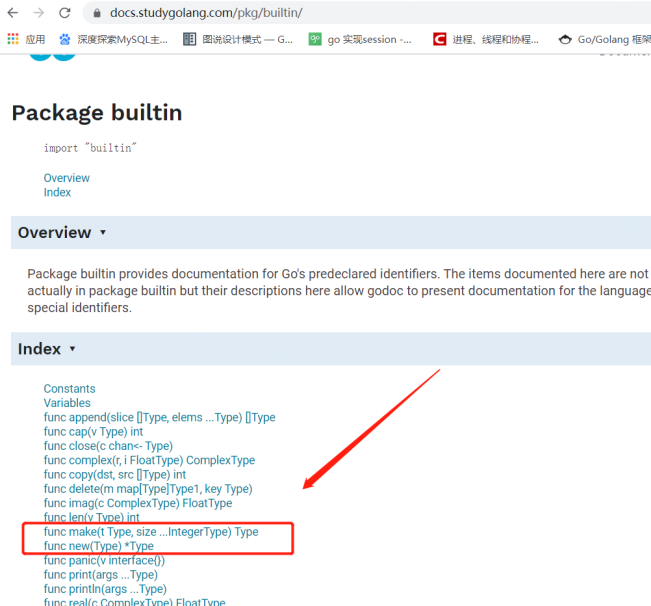本篇文章给大家分享的是有关Golang中make和new如何使用,小编觉得挺实用的,因此分享给大家学习,希望大家阅读完这篇文章后可以有所收获,话不多说,跟着小编一起来看看吧。
在golang中,make和new都分配内存,但是它们之间仍然存在一些差异。只有了解它们之间的差异,才能在适当的场合使用它们。
简而言之,new只是分配内存,而不初始化内存;make分配并初始化内存。所谓的初始化就是给一个类型赋一个初始值,例如,字符为空,整数为0,逻辑值为false。
从Golang的官方文档的builtin(内置的软件包)中可以找到,make和new的用法。

new的使用介绍:
我们先来看看new的定义
// The new built-in function allocates memory. The first argument is a type, // not a value, and the value returned is a pointer to a newly // allocated zero value of that type. //内建函数new分配内存。其第一个实参为类型,而非值。其返回值为指向该类型的新分配的零值的指针。 func new(Type) *Type可以看出,它的参数是一个类型,返回值是指向该类型的内存地址的指针,并且分配的内存将被设置为零,即该类型的零值,即字符为空,整数为0,逻辑值为false
看一些例子
type P struct { Name string Age int } var a *[2]int var s *string var b *bool var i *int var ps *P a = new([2]int) s = new(string) b = new(bool) i = new(int) ps = new(P) //structure fmt.Println(a, " ", *a) fmt.Println(s, " ", *s) fmt.Println(b, " ", *b) fmt.Println(i, " ", *i) fmt.Println(ps, " ", *ps)输出如下:
&[0 0] [0 0] 0xc0000821e0 0xc0000a409a false 0xc0000a40b0 0 &{ 0} { 0}上面基础类型,我们看一下slice, map and channel类型是如何操作的:
//map 操作 var mp *map[string]string mp = new(map[string]string) //注释掉下面的行,new map 返回为nil,直接使用会panic //*mp = make(map[string]string) // if this line is omitted, it will pan "Pan: assignment to entry in nil map"“ (*mp)["name"] = "lc" fmt.Println((*mp)["name"]) // slice 操作 var ms *[]string ms = new([]string) // 注释掉下面的行访问的时候会下标超出范围 //*ms = make([]string,5) // if this line is deleted, it will "panic: runtime error: index out of range" (*ms)[0] = "lc" fmt.Println((*ms)[0])从上面可以看出,silce,map,channel和其他类型是引用类型。当引用类型初始化为nil时,不能直接分配nil,也不能使用new来分配内存,还需要使用make来进行分配。
make的使用介绍:
我们看一下make的定义
/ /The make built-in function allocates and initializes an object of type // slice, map, or chan (only). Like new, the first argument is a type, not a // value. Unlike new, make's return type is the same as the type of its // argument, not a pointer to it. The specification of the result depends on // the type: // Slice: The size specifies the length. The capacity of the slice is // equal to its length. A second integer argument may be provided to // specify a different capacity; it must be no smaller than the // length. For example, make([]int, 0, 10) allocates an underlying array // of size 10 and returns a slice of length 0 and capacity 10 that is // backed by this underlying array. // Map: An empty map is allocated with enough space to hold the // specified number of elements. The size may be omitted, in which case // a small starting size is allocated. // Channel: The channel's buffer is initialized with the specified // buffer capacity. If zero, or the size is omitted, the channel is // unbuffered. //切片:size指定了其长度。该切片的容量等于其长度。切片支持第二个整数实参可用来指定不同的容量; 它必须不小于其长度,因此 make([]int, 0, 10) 会分配一个长度为0,容量为10的切片。 //映射:初始分配的创建取决于size,但产生的映射长度为0。size可以省略,这种情况下就会分配一个小的起始大小。 //通道:通道的缓存根据指定的缓存容量初始化。若 size为零或被省略,该信道即为无缓存的。 func make(t Type, size ...IntegerType) Type可以看出,它返回的是类型本身而不是指针类型,因为make只能为slice,map,channel等初始化内存,并且它们返回引用类型,因此不必返回指针
让我们看一些make的例子:
mm :=make(map[string]string) mm["name"] = "lc" fmt.Println(mm["name"]) mss :=make([]int,2) mss[0] = 100 fmt.Println(mss[0]) ch :=make(chan int,1) ch <-100 fmt.Println(<-ch)总结:
make仅用于分配和初始化slice,map和chan类型的数据。new可以分配任何类型的数据。new分配返回一个指针,即Type * Type。make返回一个引用,该引用为Type由make分配的空间之后,清除并初始化由new分配的空间。
以上就是Golang中make和new如何使用,小编相信有部分知识点可能是我们日常工作会见到或用到的。希望你能通过这篇文章学到更多知识。更多详情敬请关注亿速云行业资讯频道。
亿速云「云服务器」,即开即用、新一代英特尔至强铂金CPU、三副本存储NVMe SSD云盘,价格低至29元/月。点击查看>>
免责声明:本站发布的内容(图片、视频和文字)以原创、转载和分享为主,文章观点不代表本网站立场,如果涉及侵权请联系站长邮箱:is@yisu.com进行举报,并提供相关证据,一经查实,将立刻删除涉嫌侵权内容。
原文链接:https://www.toutiao.com/a6872330779859681805/